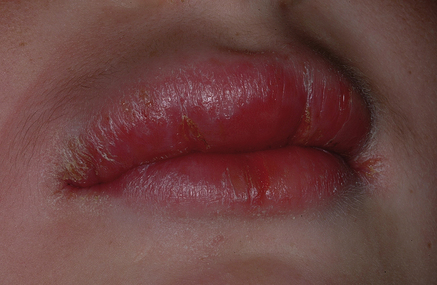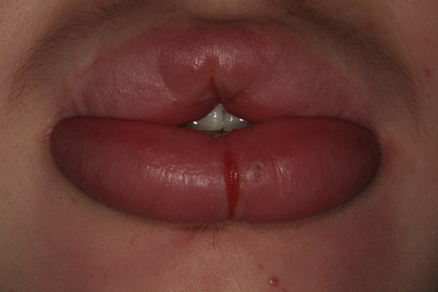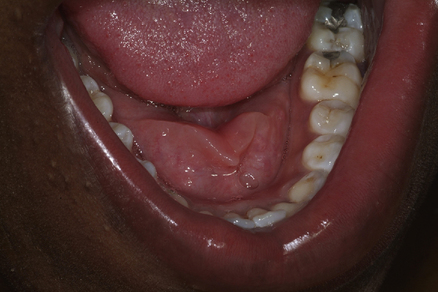Orofacial granulomatosis
INTRODUCTION
Orofacial granulomatosis (OFG) is an uncommon condition very similar to Crohn disease, due to granulomatous inflammation (Fig. 46.1) and often presents with granulomatous cheilitis, a rare, chronic swelling of the lip. OFG can also manifest with angular stomatitis and/or cracked lips (Fig. 46.2), ulcers, mucosal tags, cobble-stoning or gingival hyperplasia.
AETIOLOGY AND PATHOGENESIS
 probably mediated by cytokines such as tumour necrosis factor (TNF) alpha, and by protease-activated receptors (PARs), matrix metalloproteinases (MMPs) and cyclo-oxygenases (COXs)
probably mediated by cytokines such as tumour necrosis factor (TNF) alpha, and by protease-activated receptors (PARs), matrix metalloproteinases (MMPs) and cyclo-oxygenases (COXs)
 submucosal and chronic with many Th1 and mononuclear, IL-1 producing cells and large, active, dendritic B cells
submucosal and chronic with many Th1 and mononuclear, IL-1 producing cells and large, active, dendritic B cells
 associated with non-caseating granulomas in the lamina propria, which appear to cause lymphatic obstruction and lymphoedema, resulting in the clinical swellings (Fig. 46.3).
associated with non-caseating granulomas in the lamina propria, which appear to cause lymphatic obstruction and lymphoedema, resulting in the clinical swellings (Fig. 46.3).
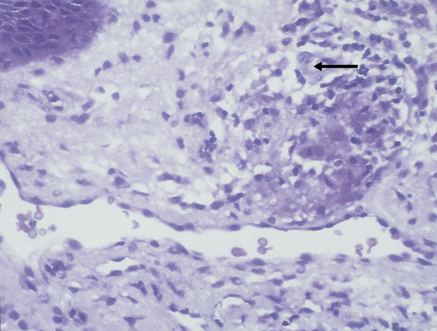
CLINICAL FEATURES
 Non-tender swelling and enlargement of one or both lips (Figs 46.1 and 46.2). At the first episode the swelling typically subsides completely in hours or days, but after recurrent attacks the swelling may persist, slowly increases in degree and eventually becomes permanent. The lip involved may feel soft, firm or nodular on palpation. Swellings involve, in decreasing order of frequency, the lip and one or both cheeks. Less commonly, lingual, palatal, gingival and buccal swellings also may occur. The forehead, the eyelids or one side of the scalp may be involved as well or in isolation. The normal lip architecture is eventually chronically altered by the persistence of lymphoedema and non-caseating granulomas in the lamina propria. Once chronicity is established, the enlarged lip appears cracked and fissured, with reddish brown discolouration and scaling becomes painful and eventually acquires the consistency of firm rubber.
Non-tender swelling and enlargement of one or both lips (Figs 46.1 and 46.2). At the first episode the swelling typically subsides completely in hours or days, but after recurrent attacks the swelling may persist, slowly increases in degree and eventually becomes permanent. The lip involved may feel soft, firm or nodular on palpation. Swellings involve, in decreasing order of frequency, the lip and one or both cheeks. Less commonly, lingual, palatal, gingival and buccal swellings also may occur. The forehead, the eyelids or one side of the scalp may be involved as well or in isolation. The normal lip architecture is eventually chronically altered by the persistence of lymphoedema and non-caseating granulomas in the lamina propria. Once chronicity is established, the enlarged lip appears cracked and fissured, with reddish brown discolouration and scaling becomes painful and eventually acquires the consistency of firm rubber.
 Thickening and folding of the oral mucosa produces a ‘cobblestone’ type of appearance and mucosal tags (Figs 46.4 – 46.6). Purple granulomatous enlargements may appear on the gingiva.
Thickening and folding of the oral mucosa produces a ‘cobblestone’ type of appearance and mucosal tags (Figs 46.4 – 46.6). Purple granulomatous enlargements may appear on the gingiva.
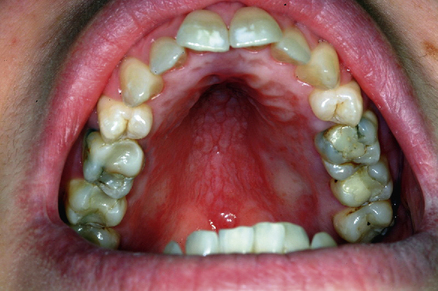
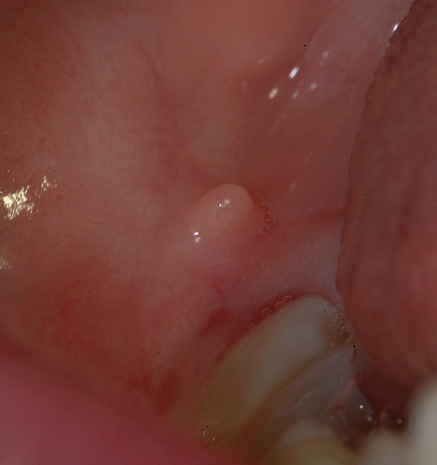
 Ulcers appear: classically involving the buccal sulcus where they appear as linear ulcers, often with granulomatous masses flanking them.
Ulcers appear: classically involving the buccal sulcus where they appear as linear ulcers, often with granulomatous masses flanking them.
 The attacks of OFG are sometimes accompanied by:
The attacks of OFG are sometimes accompanied by:
 fever and mild constitutional symptoms, including headache and even visual disturbance
fever and mild constitutional symptoms, including headache and even visual disturbance
 loss of sense of taste and decreased salivary gland secretion
loss of sense of taste and decreased salivary gland secretion
 cervical lymph node enlargement
cervical lymph node enlargement
 central nervous system defects are sometimes reported, but the significance of the resulting symptoms is easily overlooked as they are very variable, sometimes simulating disseminated sclerosis, but often with a poorly defined association of psychotic and neurological features. A/>
central nervous system defects are sometimes reported, but the significance of the resulting symptoms is easily overlooked as they are very variable, sometimes simulating disseminated sclerosis, but often with a poorly defined association of psychotic and neurological features. A/>
Stay updated, free dental videos. Join our Telegram channel

VIDEdental - Online dental courses







